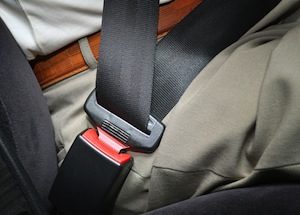 Buckle up for safety, buckle up.
Buckle up for safety, buckle up.
Click it, or ticket.
When you get in a motor vehicle, one of the first things you do is put on your seat belt. You do this to keep yourself safe if you are involved in an accident. The seat belt is the primary safety device in your vehicle. If a seat belt fails, there can be dangerous, even fatal, consequences.
We are trained from childhood that to be safe in a vehicle, we must wear our seat belt. Sometimes, however, seat belts fail to protect during a crash. Seat belts can fail for several reasons:
- Seat belts can unlatch during an accident. They can unlatch inertially, when crash forces cause the buckle to release. They can unlatch inadvertently, when accidentally hit by an occupant or something in the vehicle during the accident. Sometimes, a seat belt buckle can look, sound and feel like it is locked when in fact it is not. In this false latching situation, the buckle can easily come undone in a crash, leaving the occupant unprotected.
- Seat belts can spool out. Seat belts are supposed to lock up during an accident. When the locking mechanism fails, the seat belt can spool out, allowing an occupant to be thrown forward or sometimes to even come out of the belt restraint.
- Seat belts can fail to protect occupants of certain sizes. Seat belt designers often overlook smaller sized occupants. Children and smaller adults often find the lap belt sitting too high on their abdomens or the shoulder belt lying on their necks rather than shoulders. This poor design can lead to serious injuries or even death in an otherwise survivable accident.
Defective seat belts can case catastrophic, often fatal, injuries. These life-changing injuries can change an occupant’s life forever. The most common injuries from seat belt failure are injuries to the heat and neck, chest injuries, and injuries to the arms or legs; these injuries can lead to permanent disabilities. If a seat belt fails in a head on collision, an occupant can be thrown into the windshield. If a belt fails during a rollover, an occupant can be ejected from the vehicle and sustain spinal cord or neck injuries which can result in quadriplegia, paraplegia, paralysis or death.
Causes of seat belt failure may include:
– Faulty material used for webbing;
– Poor design or geometry;
– Manufacturing or assembly errors or defects;
Careless and negligent motor vehicle manufacturers and seat belt manufacturers should be held responsible for injuries a defective seat belt can cause.
Signs of a possible seat belt defect include:
– A seat belt is found damaged or torn following an accident;
– A belted victim suffers injuries in an accident in which there is little damage to the vehicle;
– An occupant is found unbelted after an accident, but the occupant insists he was belted during the accident;
– A belted occupant sustains much more serious injuries than other occupants of the vehicle at the time of an accident.
If you experience a seat belt failure and believe any of these situations exist, you should investigate for a seat belt defect. The lawyers of Wolff Ardis, P.C. can help you. The lawyers at Wolff Ardis will investigate all facts, study the seat belt and buckle, and study the marks in the vehicle and on the occupant to determine if a defective seat belt caused or added to your injuries.
Buckle up for safety, buckle up.







